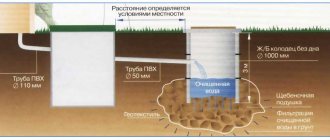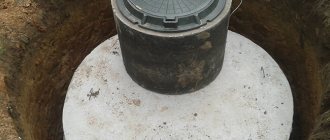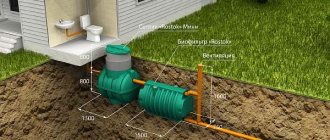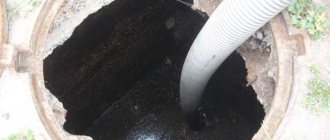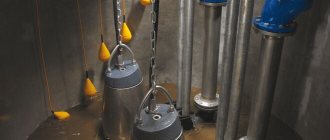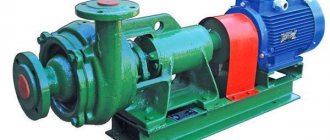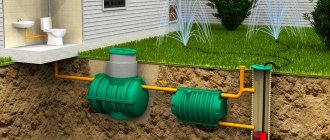For home improvement in different areas, different types of autonomous sewage systems are most acceptable, and the correct calculation of the cesspool is of no small importance. Before starting work, you need to decide on the volume of the future septic tank, as well as its size. This article provides methods for calculating both sealed and filtering septic tanks without a bottom. In addition, you can see an example of calculating the amount of materials required for installation.
The construction of a drainage pit begins with calculations of its volume
Features of arranging a cesspool
In urban environments, people enjoy all the benefits of civilization. Outside the boundaries of megacities there is no running water or sewerage system. One of the pressing issues is ensuring the drainage of wastewater during the construction of a private house. The basic rule is that during operation the structure should not pollute the site or the environment.
In a private building, a cesspool is designed in accordance with SanPiN 42-128-4690-8 and SNiP 30-02-97. The Regulations provide for the following rules:
- Storage and cleaning tanks are located in the area adjacent to the house, no closer than 10 m to the dwelling.
- The distance to the water supply is at least 10 meters, to a well or well – 20.
- According to some standards, a cesspool is allowed to be installed at a distance of 5 meters from a living space if the plot size is small.
- The system is located no closer than 2 meters from the border of the neighboring plot.
- According to SNiP, the depth of the pit should not exceed 3 meters.
- The permissible distance from the bottom to the groundwater level is at least a meter.
Besides:
- the structure must have a sealed cesspool and a ground part closed with a lid;
- filling the underground part is permitted no higher than 35 cm from the top of the pit;
- cleaning is carried out as it is filled, but not less than twice a year.
- disinfection is required.
The system should be located below the water intake well along the slope of the site. Wastewater from the house flows by gravity through pipes connected to the pit.
Arranging a cesspool is not a complicated process, but it is labor-intensive, as it involves excavation work. There are no special requirements for its type and design, since the entire system is located in the ground.
How to calculate the volume of edged boards
The volume of one board is determined in the same way that was used at school - by multiplying the length by the width and thickness.
Or multiplying the width by the length and thickness. It doesn't matter in what order you multiply the board sizes, the result will always be the same. For example, a standard “fifty” board has the following dimensions:
- length 6 meters; width 20 centimeters; thickness 5 centimeters.
- As a result of multiplication, we get the volume of one board of 0.06 cubic meters. After this, we divide the unit by 0.06 and get the number of boards in one cubic meter. We get the number 16.6666, which must be rounded to the nearest integer, that is, to 16, which will be the number of boards is “fifty” in one cubic meter. It is always necessary to round down, because some of the boards may be slightly wider or thicker, they may not be laid tightly, or several boards from the package may be twisted. If all the boards turn out to be normal, then fractions can also be taken into account; this is especially true for thick timber.
Design selection
Cesspool without a bottom and sealed
The options differ in the material of manufacture, the principle of operation, and the duration of operation. Based on the principle of operation, there are two main types. The sealed structure consists of a closed bottom and strong walls. It can be single-chamber or consist of several compartments. The tanks are connected to each other by pipes and equipped with biological filters and pumps. Such drainage containers do not harm the environment, but they quickly become dirty and require regular cleaning.
Pits without a bottom absorb accumulations from all layers of soil. One of the simplest tanks is a cesspool made from car tires. This is a budget option. It has a small volume, is not cleaned and quickly silts up.
The service life of a tank made from barrels depends on the quality of the metal. If you choose expensive material with an anti-corrosion coating, the device will last for many years.
There are special plastic containers. If the pit volume is up to 1m3, polypropylene barrels can be used.
A brick structure becomes unusable due to the decomposition of the material under the influence of moisture. Walls can be repaired with concrete inserts, extending their service life.
The best option in terms of quality and cost are concrete rings. They do not rot and are resistant to soil movement. The service life of such a device can be up to 100 years.
Classification and volume of reinforced concrete rings
These rings are made of heavy concrete B25, frost resistance of which is F-100, water permeability of W4. Reinforced concrete rings are marked, according to which the classification of the ring can be determined.
First, the marking indicates the type of structure: KS - wall ring, KSD - wall ring with a bottom. After the type, the size of the ring is written, the first group of numbers indicates the diameter of the ring, after the hyphen - the height of the product. For example, KS-15 designates a wall ring with a diameter of 1500 cm.
When installing a cesspool on a site, first of all, the size of future sewage is taken into account. Depending on the depth of the sewage pit, the required number of reinforced concrete rings and their types are calculated.
The standard height of the rings is 90 cm, but if necessary, the design can be supplemented with rings of other sizes. Depending on the needs, the diameter is selected - from 70 to 200 cm. The thickness of the concrete wall is 7-14 cm.
The strength of the structure largely depends on the bottom well ring - experts recommend installing a ring with a bottom. Next come the wall rings and the cesspool is closed with a lid with a hatch. The diameter of the septic tank elements must be the same everywhere, otherwise the structure will be unstable and sewage may leak into the ground.
Calculation rules
Before erecting a structure, you need to calculate the volume of the cesspool. You need to start from the number of permanent residents in a given building. A person uses about 150 liters of water per day. These are the costs of cooking, washing dishes, laundry, showers and baths, and toilets.
A family of three will drain into a cesspool per day: 3*150=450 liters. The sealed pit is cleaned every 15 days. In two weeks, 6,750 liters or 6.75 m3 of waste will accumulate. It is necessary to lay down a reserve for unforeseen situations. The volume of the tank in this case will be equal to 9 m3. For a country house where people stay for a short time during planting and harvesting, it is enough to have a capacity of 1–2 m3.
The device without a bottom is cleaned by anaerobic bacteria, and the wastewater partially goes into the ground. Such structures also require periodic pumping. Special biological products can be used to lengthen the period. The calculation is made for the maximum possible volume of wastewater.
To the average consumption of 150 liters per person, add wastewater from household appliances that use water. Thus, the volume increases to 50 liters per day. A family of three requires a minimum of 600 liters of waste water. To determine the volume of the pit, the amount per day must be increased three times, and will be 1.8 m3.
Area of the ring expressed in terms of outer and inner radii
Let a circle of radius R and a circle of radius r be given. Moreover, R>r. Let's align the centers of these circles. The figure enclosed between these circles will be a ring, with R being the outer radius and r being the inner radius. Then the area of this figure will be equal to the difference between the one with the larger radius and the area of the circle with the smaller radius.
The area of a circle with radius r is expressed by the formula: The area of a circle with radius R is expressed by the formula:
Then the area of the ring will be equal to:
Thus, the area of the ring is equal to the product of the number and the difference between the squares of the outer and inner radii:
An example of calculating the area of a ring if its radii are known. Find the area of the ring if its outer radius is 3 and its inner radius is 2
Calculation of sides
The required cubic capacity affects the parameters of the well. There are no clear rules for aspect ratio. It is necessary to calculate based on the depth of groundwater. The standard pit depth is 2.5–2.7 meters. The pit for the cesspool is a parallelepiped. The calculation of its sides is as follows:
Volume formula: V=a*b*h,
where a is the length,
b – width,
h – height,
then the width is b=a*h/V,
length a= b*h/V
If the required volume is 9 m3, we obtain the following parameters:
- depth 2.0 m;
- length 3.0 m;
- width 1.5 m.
It is not recommended to make cesspools deeper than three meters. If necessary, in leaky devices the level can be raised using a sand-crushed stone cushion.
The sewer truck is equipped with a hose about three meters long. If the hole is deeper, it will not be cleared of silt and hard build-up at the bottom. When positioning the device, you should take into account the access routes for equipment.
If the groundwater level is high, installing a cesspool is not advisable. During a flood, it will be filled with groundwater. In this case, it is better to choose septic tanks or use barrels of suitable diameter. They should be protected with a concrete or metal casing.
Tips from professionals for construction
When doing all the work with your own hands, professional builders recommend:
- Backfilling a three-cube tank requires at least 1.5 m³ of soil.
- After concreting the bottom, the mixture must stand for at least 10 days to achieve the required strength.
- For brickwork, errors are acceptable. Because the main function is to keep the soil from crumbling, and slightly uneven rows do not affect the quality of the task performed.
- For formwork, corrugated sheets or boards are best suited.
- Compact and level the soil around the entire perimeter and on top of the well.
A large selection of designs allows you to make a device that will correspond to your financial capabilities, and using the above tips, each owner will be able to independently build a reliable cesspool.
Main difficulties
The main errors that arise during calculations are:
- Unwillingness to stick to the project plan.
- Refusal to add soil freezing level indicator to the formula.
- Lack of desire to double-check during the digging process.
There are builders who take measurements “by eye”, relying on their experience, so engineers recommend double-checking the compliance of the foundation marking numbers with the numbers indicated in the plan 2-3 times. This will help to avoid difficulties during the construction process when laying the foundation and future communications.
The main difficulty in calculating the size and volume of trenches is also the lack of desk processing. Despite the fact that it is carried out by experienced specialists, even they make errors in the calculations. Here it is important to correctly make geodetic measurements based on the primary topographic survey.
There is no need to skimp on marks, and proper fixation of such dimensions as the top and bottom of the trench, the height of the slopes, and marks inside the pit is required. A correct counting system must necessarily correspond to the truth. Fictitious measurements will be a huge construction mistake and will cause problems in the future.
Camera data should be processed as quickly as possible , as they can be erased and lost. It is necessary to record the obtained result. Inconsistencies in measurements must be rechecked several times. When shooting, attention is paid to protruding reference points.
To avoid errors in calculations, you need to plan the construction of the recess horizontally. If the calculation is very complex, you need to double-check it several times.
If a construction company works with professionals, then you should not bother with the cartogram and pivot table. The specialist will take measurements not only using a topographic survey, but also manually, using special construction tools.
Fines for violations
For any violations of the construction or operation of a cesspool, the legislation of the Russian Federation provides for a fine.
However, its size will depend on the severity of the violation, as well as on the number of previously recorded cases of ignoring regulatory documents.
Diagram of daily waste volume
For example, the standards stipulate that a pit with a filter bottom can only be equipped if the daily volume of wastewater does not exceed 1 m3.
Otherwise, the owner of the land plot faces a fine.
Its size will be determined by the court, because it is in court that the issue of choosing a punishment will be decided.
But it should be understood that this is a serious violation of environmental standards, so the fine can reach several thousand rubles.
Well with filter bottom
If a complaint is received from neighbors and a single violation of the rules for operating a cesspool is discovered, then the owner will first be issued a warning with a strong recommendation to eliminate the problem.
If sanitary standards for the operation of a cesspool continue to be violated, there is a risk of receiving a fine. The maximum fine for a cesspool without a bottom is 500 rubles. (according to the Code of Administrative Offenses of the Russian Federation, Article 6.3. Violation of legislation in the field of ensuring the sanitary and epidemiological well-being of the population).
At the same time, its size may increase, especially in cases where the owner of a private plot ignores warnings and penalties more than once.
It is necessary to monitor the condition of the cesspool
In addition to a fine, which can reach 500 rubles, the court may order the drain to be remodeled, moved, or completely eliminated.
This is relevant in cases where the distance of the cesspool from its neighbors according to SNiP is violated.
In view of this, it is better to initially carry out construction taking into account all norms and distances.
Cesspool location, diagram
What sizes should I consider?
It is easy to calculate the volume of simple rectangular trenches .
It is enough to know the basic dimensions (length, width and depth) and multiply them together. Accurate calculation of several recesses according to plan, for complex projects, is carried out by an experienced builder, specialist geologist or engineer.
If the planned size of the premises under construction is small, the owner can make the calculation independently, taking into account the values of three main indicators, which include:
- Length (N).
- Depth (height).
- Width (B) of the pit along the top (B1) and bottom (B2).
Since trenches come in various types: rectangular, trapezoidal and mixed, the laying of communications and strip foundations is carried out strictly according to the foundation plan, taking into account indents and slopes.
The main formula that is used when calculating indicators looks like this:
Vt = (B1 + B2) / 2 x L x H, where :
- Vt – volume of the formed recess;
- B1 – top width;
- B – bottom width;
- L – length of the pit;
- H – depth.
H (height) of the trench is a subjective concept, and is indicated in documents, taking into account soil freezing in a particular region, indicated in maps and tables of SNiP 2.02.01-83. Trenches are always made up to 40 cm deeper than the freezing level, so when making calculations, special attention is paid to this nuance.
If the calculations are carried out by an experienced builder (master) or an engineer from a partner company of a construction organization, the indicators must be entered into a special statement, which is checked and approved by specialists from the authorized authorities. Volume calculations for trenches are carried out only in cubic meters.
Application of the formula
How to calculate cubic capacity?
The formula for calculating the volume of soil in a trench for a given volume is very simple. Since most often the trenches are made rectangular, it has the following form: Vt = A x B x C, where:
- A – length;
- B – width;
- C – height (depth).
The listed quantities are measured in cm, the result obtained is always equal to cm3. Use online calculators to make calculations quickly and easily. They are offered to Internet users by professional companies advertising their earthmoving engineering services.
It is enough to enter a request for calculation in the search bar of the World Wide Web , and this service will appear in the form of a window that needs to be filled in by substituting the values. You can use an online calculator, for example, on this website.
Example: given trench length - 50 cm, width - 30 cm, depth - 70 cm. Calculate the total volume of soil that will be removed from the recess.
How to calculate? Since the volume of soil that is in the trench mathematically corresponds to the volume of the depression itself, all calculations will be carried out according to the formula: Vt = A x B x C = 50 x 30 x 70 = 105,000 cm3 = 0.105 m3. Answer: the total volume of soil in the trench will be 0.105 m3.
In 2021, for more complex calculations, many builders began using the AutoCAD program . It allows you to work with diagrams and drawings in three dimensions, offers an online calculator, as well as error checking in working documentation.


